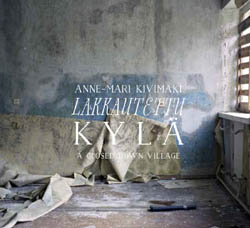|
Anne-Mari Kivimäki / Suistamon Sähkö
|
|
Anne-Mari Kivimäki
Suistamon Sähkö Photos from the book Lakkautettu Kylä by Hanna Koikkalainen
Lakkautettu Kylä (A Closed-Down Village) is at once the denser and more spacious of the two albums. Denser because of its overtly narrative approach and numerous musicians; spacious because of its gracious breathing room. Originally conceived as a sound installation that also included photographs by Hanna Koikkalainen (click on the images below), words and music alike convey the sorrows and tainted hopes of the Finnish diaspora of WWII.
Through a simpatico assembly of instruments—including fiddle, bowed lyre, clarinet, harmonium, bass, kantele, and percussion, all led by Kivimäki on accordion and vocals—one can almost feel these still images turning into moving ones. So the journey begins with “Suistamo Soundscape 2014.” Grassy footfalls share the air with a cuckoo's call buzzing insect in this unfiltered field recording, situating us in the landscape proper, and in the memories lingering there. As if to emphasize this sensation, two wartime songs from the early 1940s dot the program with their distinct timestamps. Both “Life in the Trenches” and “Lake Onega Waves” nourish themselves on Kivimäki's attention to inhale and exhale. The occasional bleed-through of Russian syncopations feels all the more bittersweet from where the present listener stands.
Also bittersweet are the archival recordings of famed Finnish storyteller and guitarist Ilja Kotikallio, whose voice, even in the absence of translation, conveys a musicality very much its own. The program is further signposted by two iterations of “Surua” (Sorrow). One is an a-capella piece that kneads chords into a cautious procession. The other is one of Kivimäki's most evocative compositions, a mid-tempo trek through forest that compresses days of uncertainty into a tense four minutes. The combination of accordion, drum, and bass kantele speaks with the same stoic determination that surely set the faces of its dedicatees in the glare of exile. “Ljuuli” carries that torch with the palpitations of a tattered heart.
In all of this is a wisdom born of hardship, a realization that even in the darkest hour one must preserve the dance, and the music accompanying it, as a safety net. Karelian traditions thus pulse their way through every image. Whether in the crystalline requiem of “Lipitsä” (which pays homage to Timo Lipitsä, noted singer and kantele player of Suistamo who lived 1858-1950) or in the traditional “Säkkijärven Polkka,” the dance offers harmony and hope. The post-production of such tunes lends an antique patina, as if each were plucked out of a dusty attic and placed on a turntable for the first time in decades.
Kivimäki's accordion possesses melodic authority, even as it recedes to let other voices shine, as most resolutely in “Kaivos” (Mine) and “Rauha ja Hiljaisuus” (Peace and Silence). In both is the assurance that, no matter how big the waves, one can always carry inside those intangible things that cannot ever be washed away. Even as these ending credits roll, we can feel them turning into the opening credits of another chapter, as continued by the ensemble Suistamon Sähkö (Suistamo Electricity). Here Kivimäki is joined by three vocalists only, of whom Eero Grundström provides a backbone of electronics throughout. The result is an ingenious, self-styled “folktronica” experiment. While it might seem like a gimmick in theory, in practice the presence of electronics gives apt traction to an album themed around hydroelectric power plants and cartographic resonances. Its undercurrents float through the opening “Kotiin” (Homewards) with persistent grit, adding freshness to the spoken portions. This song's condemnation of war and bloodshed also sets the album's activist tone.
All of these elements speak to Kivimäki's brilliance as a concept artist. Not only does she create music to be enjoyed on its own terms, but also to be read like a text with something worthy to say. For the most part, underlying messages ring loudly and clearly. The title song's eclectic persona of old sound bites and other digitalia (further enhanced by field recordings of the very power plants, still operational, that once provided electricity to Suistamo) is every bit the storyteller as Kotikallio, who makes another cameo in the wedding-themed “Svuadpoi.” These emotions move just as weightily as the heartbreaking “Saarella Palaa” (The Island is Burning), which tells of the 400,000-strong migration of Karelians forcefully evacuated with little more than the clothing on their backs, and of evacuees' return in “Kalevala-Kuolema” (Kalevala Death) to a homeland as sunken as their resolve. While such themes might not seem ripe for club beats, Grundström's contributions variously depict a tightening of a chest, the flare of an occasional hope, and the prospect of going home.
Equally intriguing are the hip-hop-inspired “Suistamon Soitto” (Suistamo Music) and “Karjalaisen Laulu” (Song of the Karelians). Both use rap to at once enhance and break through traditional sentiments, paying tribute, for example to unsung heroes of the Karelian evacuation, like the women whose inner strength was rarely acknowledged in the lyrical tradition. Even humorous songs such as “Miitrein Hotellilla” (At Miitrei's Hotel), about Suistamo's most famous resident jester, and the tongue-in-cheek “Kankkuspäivästä Karjala” (A Hangover Day becomes Karelia) strike their flint on critical stone. Like the techno-ish “Pyörittäjä,” it bids us to dance where only ashes remain, so that we might know the aftermath while imagining the joy that preceded it. - Tyran Grillo
Other recordings in the "Suistamo Suite"
Anne-Mari Kivimäki: www.annemarikivimaki.fi
All photos by Hanna Koikkalainen: www.hannakoikkalainen.com
|

Get your copy for a one time contribution of 21.00 (postage included).
| ||||||||||||
|
|